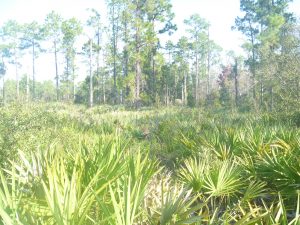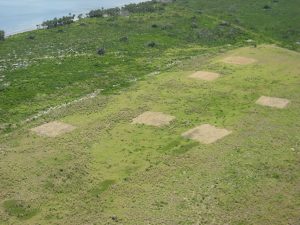The following section highlights research themes for my lab.
1. Characterizing and predicting species responses to climate change
Contrary to the majority of studies which have been conducted in more northern regions, my research team and I discovered that plants in Florida are flowering later. We identified that Florida winters are getting colder, leading plants to flower later, even though average annual temperatures are trending up.
I am interested in unveiling differences between native and nonnative plant species response to climate change with field and greenhouse experiments. I explore mechanisms for differences in response to climate change by native and nonnative plant species with growth chamber experiments and niche modeling. In a large-scale field-based experimental manipulation, I am testing the hypothesis that the global change factors of nitrogen deposition and human disturbance will have additive or synergistic effects on plant establishment into new habitats.

I led a team of fifteen researchers, including sea turtle biologists, ecological and climate modelers, and engineers to investigate the effects of sea level rise on coastal nesting species along the South Atlantic Bight. The goal of this US Fish and Wildlife Service funded research was to evaluate past nesting patterns and predict future effects of sea level rise on nesting beaches of sea turtles, seabirds, shorebirds, and beach mice populations across the South Atlantic Bight. This interdisciplinary team found that over 2,000 km (43%) of the South Atlantic Bight coastline is projected to have an increase in coastal erosion vulnerability by the 2030s, with respect to its present vulnerability. Future vulnerability of SLR-induced erosion along the South Atlantic Bight is spatially variable, and the 11 coastal study species also varied in their use of coastal habitats with high future coastal vulnerability to SLR. For example, only 23% of high-density nesting habitat for the brown pelican (Pelecanus occidentalis) is expected to be at increased vulnerability to SLR, whereas >70% of the high-nesting density habitat for two seabird species (gull-billed tern [Gelochelidon nilotica], sandwich tern [Thalasseus sandvicensis]) is predicted to have higher future coastal erosion vulnerability by 2030.
2. Predicting climatically-induced species range expansion
In collaboration with many undergraduate volunteers and an undergraduate researcher, I conducted a growth chamber experiment to understand how biotic interactions, specifically soil microbes (microscopic bacteria, fungi, viruses and other organisms), influence the potential for closely related native and nonnative plants to expand their ranges with climate change. Soil microbes had a net negative effect on the invasive plant, Eugenia uniflora (Surinam cherry) across all sites and temperature treatments. This negative response to soil microbes suggests that E. uniflora’s invasive success and potential for range expansion are due to other contributing factors, e.g. higher germination and growth relative to native Eugenia. The effect of soil microbes on the native species depended on the geographic provenance of the microbes, and this may influence range expansion of these native species.
In collaboration with Drs. John Weishampel and Marta Lyons, we are exploring a novel way of predicting sea turtle range shifts with climate change, by using physiological traits as a basis for predicting organismal response to global change factors.
3. Ecological restoration and global change mitigation
My former graduate student, Annie Weiler, conducted a paired experimental restoration in Merritt Island, Florida, in habitat with very similar soils to our Martha’s Vineyard site. In this system, we found that removing vegetation by tilling and topsoil removal is an effective method for reducing non-native cover.

I am conducting a National Park Service (NPS)-sponsored restoration project at Cape Cod National Seashore (CCNS) in collaboration with my former graduate student, to investigate disturbance requirements for the long-lived rare shrub, Corema conradii. Additionally, I just completed a large-scale field-based experimental manipulation to test the hypothesis that the global change factors of nitrogen deposition and human disturbance will have additive or synergistic effects on plant establishment into new habitats, which will vary by species functional type. I will use the results of this project to explore ways to mitigate the negative effects of atmospheric nitrogen deposition on plant communities in coastal New England.

I am interested in exploring cost-effective restoration treatments for rare native species, and am experimentally investigating the most appropriate way of restoring the Maryland state-listed species, Pycnanthemum virginianium (Virginia mountain mint), in collaboration with Ted Hoxie, undergraduate student at Frostburg State University. We will implement fire, mowing, and nitrogen-deposition treatments at the C&O Canal National Historic Park (Chesapeake & Ohio Canal National Historical Park (U.S. National Park Service) (nps.gov))to understand how to restore this rare species.

4. Globally distributed ecological experiments
I am collaborating with a global team of ecologists to assess the generality of factors influencing disturbance recovery and community assembly in herbaceous-dominated ecosystems (DRAGNet: DRAGNet – Home (weebly.com)). I set up a site at the Izaac Walton League of America’s Bethesda-Chevy Chase site (Bethesda-Chevy Chase Chapter of the IWLA – Conservation Sportsmen & Sportswomen (bcciwla.org)) in the Fall of 2022, with the help of Chander Sam, GWU undergraduate student, IWLA members, and the Global Ecology Program at the Poolesville (MD) High School Poolesville HS – Global Ecology | Poolesville HS (montgomeryschoolsmd.org).


